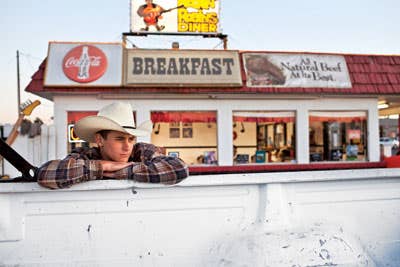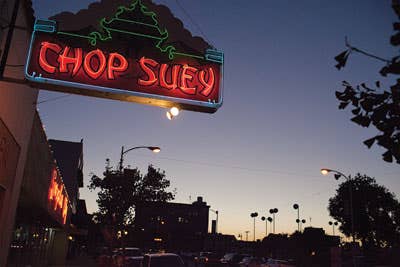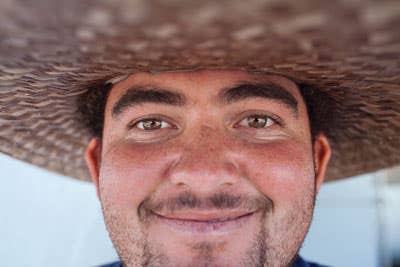
Heart of the Valley
California’s Central Valley is the most productive agricultural region on Earth; it’s also just a great place to eat
In The Grapes of Wrath, John Steinbeck's Joad family "drove through Tehachapi in the morning glow, and the sun came up behind them and then—suddenly they saw the great valley below them…. The vineyards, the orchards, the great flat valley green and beautiful, the trees set in rows, and the farm houses…. Pa sighed, 'I never knowed there was anything like her…' Ruthie and Winfield looked at it, and Ruthie whispered, 'It's California.'"
It was indeed California, but not the one travel agents advertise. This is the southern end of California's Great Central Valley; it is called the San Joaquin, while the northern section is termed the Sacramento, both named for their major rivers. The entire Great Valley is an enclosed prairie, geologically an ancient seabed in a trough between uplifted mountains, nearly 450 miles long and up to 90 miles wide. The entire area is about the size of Egypt.
This is where I am from. A great-great grandfather of mine from Missouri, on my father's side of the family, entered the Valley in the 1840s in search of free land for a farm. An ancestor of my mother migrated north from Mexico across the border in the 1850s to work as a vaquero, or cowboy. I grew up in Oildale, in the Valley's southern reaches, as the son of an oil worker; like most working-class kids, I earned my spending money as a seasonal farm laborer. I irrigated sugar beets, swamped seed potatoes, and drove tractors in Arvin, east of Bakersfield.
My experience here has shaped the way I think about food—about where it comes from, how it grows, and where it goes. The San Joaquin Valley is considered to be the most productive agricultural region in the world; more than 50 percent of California's crops come from here. Paul F. Starrs and Peter Goin, in their definitive Field Guide to California Agriculture (University of California Press, 2010), refer to it as "the agricultural giant in California," which means something when you consider that California is the country's leading farm state. If you buy a bunch of asparagus in Iowa or Indiana, chances are it was grown in the Valley and shipped out of a huge refrigerated warehouse in Stockton or Fresno; same goes for grapes, almonds, pistachios, oranges, pomegranates, and prunes.
Because soil and sun are provided by nature, and seasonal laborers are cheap and plentiful, only aridity has been a problem for agriculture. Two massive irrigation systems have changed that: the Central Valley Project, begun in 1937, and the State Water Project, started in 1957. Both are considered incomplete, despite scores of dams and reservoirs, as well as hundreds of miles of aqueducts. This is thirsty land. A few years ago, my wife, Jan, and I were cruising south through rain-cleansed air down Interstate 5 on the Valley's western edge toward our hometown. The freeway here runs along the eastern edge of the Diablo Range, treeless but grassy hills dotted with range cattle. Then, near Kettlemen Hills, a little north of Bakersfield, an unexpected expanse of water appeared along the side of the road. I nosed our car to a stop on the highway's shoulder and gazed as if upon a ghost; this was a remnant puddle of what was once was Tulare Lake, the largest body of freshwater west of the Great Lakes. In the 19th century it provided tons of fish and turtles for San Francisco's restaurants. Then the diversion of its feeder streams to create new irrigation routes caused the lake to dry, so that only in the wettest years are locals now reminded a lake ever existed.

photo by Landon Nordeman
Elsewhere, the valley bed is irrigated cropland. From the San Joaquin's back roads, much of this cropland appears empty, fields of green without nearby farmhouses. Agriculture here is truly agribusiness, dominated by huge corporations. There are, of course, plenty of small farms, too, but corporations reign. As early as 1981, most of the 700,000 acres irrigated by the State Water Project in three prolific counties—Tulare, Kings, and Kern—were owned by just eight huge companies. This pattern, which can be traced to the earlier Spanish and Mexican land grants that concentrated huge tracts in the hands of an elite, has led to great wealth for a few, great poverty for many. Annually, five of California's ten poorest communities—populated mostly by migrant Hispanic farm laborers—are located in this cornucopian Valley.
There has always been a hard edge to life here, but until the current economic depression, the Great Valley also boasted the state's fastest growing population, and a society as varied as the multiplicity of commercial crops grown—Chinese, Dutch, Hmongs, Basques, Armenians, Sikhs, Mexicans, and, of course, plentiful varied palefaces, among many, many others. Says journalist and memoirist Richard Rodriguez, who grew up in Sacramento, "Here it is much easier to remember that the world is not simply derived from Europe." It has been estimated that more than 100 languages are spoken in the Great Valley's communities, all of them belonging to people who migrated here to be a part of the enormous engine of food production.
Yet the agricultural setting—its vast distances between built structures, its monolithic fields—can be deceptive. Driving down the more populous east side of the Valley on Highway 99, one passes through Sacramento, the state capital, then Stockton, Modesto, Merced, Fresno, and Bakersfield. These are modern cities with colleges or universities, with progressive urban centers. They are also little worlds, populated by people who may have come for seasonal labor, but who have left their indelible cultural—and culinary—mark.
Near Tulare Lake's now-desiccated shore is a town locals favor for its food: Hanford, on Highway 198. It is famous for China Alley, the remnant of a historic district founded by Chinese railroad workers in the late 1870s, and its culinary legacy: celebrated restaurants such as the Hanford Chinese Kitchen. It also hosts other gems, like the Hanford Portuguese Bakery, which offers Portuguese doughnuts and other pastries, along with cheeses, sausages, and breads. The dairy industry in the San Joaquin Valley has been dominated by Portuguese immigrants, like the Fagundes family who runs Fagundes Old World Cheese in Hanford, producing queijo fresco and other award-winning cheeses.
In Bakersfield, at the southern end of the valley, Basques who settled here in the 1890s have lent their own style of life and, of course, of dining. Old restaurants such as Noriega's and the Pyrenees Cafe that once hosted and fed bachelor shepherds from the old country, now serve vast, rib-sticking, family-style meals that have become a regional tradition. Here, at long tables, you meet fellow diners as you compete for that last slice of pickled tongue or dig into oxtail stew.
Nearby is a local Italian institution, where Jan and I sometimes grab lunch: the 101-year-old Luigi's Delicatessen. Jan orders a tri-tip sandwich—a local specialty made using meat from the lean triangle of beef cut from the bottom of the sirloin—and I get a house favorite, the "Half & Half," a half plate of pasta with savory meat sauce with a half plate of Luigi's vinegary, garlicky white beans. On the wall, my high school football team's photo from 1953 is still posted along with hundreds of other local sports shots.
You find Armenian food in Fresno at places like Bedrosian's Armenian Deli, George's Shish Kebab, and Nina's Bakery; Merced's Houa Khong features delicious Laotian and Thai fare; Asian dishes from several traditions highlight dining in Stockton at establishments such as Saigon (Vietnamese), On Lok Sam (Chinese), and Sho Mi (Japanese). Great Mexican regional foods can be had virtually everywhere in the Valley, often from what are locally called "roach coaches," roving taco trucks that turn out everything from grilled carnitas to homemade tamales to—on weekends—delicious menudo, a long-cooked tripe and hominy soup.

photo by Landon Nordeman
Despite the prevalence of factory farms, fresh produce stands are a local tradition, and they may be found on many back roads, as can more and more "pick-and-pay" farms. Mas and Marcy Masumoto in Del Rey, 15 miles south of Fresno, annually "lease" trees growing organic peaches to townsfolk like me. During the harvest season, lessees assemble on two weekends to pick their peaches, laugh at one another's ineptness, and enjoy a farm breakfast. Here, on the Masumoto's 63-year-old, 80-acre family farm—not huge by Valley standards, but certainly not small—more than a few of us are reminded of our youth spent as seasonal farm laborers.
Across the Valley on its west side, at the foot of the sparsely settled Diablo Range, can be found the remains of one of the state's oldest roads, El Camino Viejo, an 18th-century Spanish cart track. This dry region used to look like what writer Marc Reisner called the "Serengeti of North America." In the 19th century, it was populated by herds of ruminants that thrived on the semiarid grasslands: pronghorns, tule elk, mule deer, as well wild horses and cattle. The grazers were preyed upon by wolves and mountain lions, and grizzly bears were common, too, because waterways were full of salmon in season. Though visions of that natural past can be glimpsed here and there—on a recent day hike, I saw coyotes, elk, deer, and a golden eagle—this habitat has changed due to the irrigation. Not only was Tulare Lake lost, but one of the West's great salmon streams, the San Joaquin River, was sacrificed for irrigation as well. Only recently, thanks to local activists, have the courts ordered that enough water be released to maintain year-round flow in the stream. And the Valley continues to transform: Some of the older farms that replaced wildlife habitats are themselves being lost to urban and suburban development, at the rate of more than 10,000 acres a year.
But, despite the pace of change, there remains an old-timey feel to parts of the Valley. Interstate 5 skirts pleasant towns, such as Patterson and Gustine, which retain a 1950s charm. In these parts, the Valley is a place of diners whose menus and decor haven't changed in half a century. It is a land of southern conviviality, likely attributable to the Dust Bowl migrants who settled here. Pickups driven by Stetson-topped men bounce past, often with a dog braced in the bed. This was once one of America's cattle kingdoms, and Oakdale on the Stanislaus River still calls itself the "Cowboy Capital of the World." To the rodeos, stock car races, and Friday night football, add everything from Portuguese bullfights to African-American Juneteenth commemorations to Hmong New Year's celebrations, and it's easy to see the Valley for what it is: a land of both nostalgia and constant cultural churning. Car radios here broadcast Oildale's Merle Haggard, as well as the Norteño accordion of Flaco Jimenez and passionate Portuguese fados.
And when the wind has cleared the smog from the cities and agribusiness clusters, and the snowcapped Sierra Nevada that frame the east come into sight, the surrounding countryside retains a haunting quality that contrasts with the green grids of agriculture, and you understand why this place, both a heaven and a hell, has been considered by migrants, long before the Joads and long after, to be California's heart.
Keep Reading
Continue to Next Story










